
A wind farm or wind park, also called a wind power station or wind power plant, is a group of wind turbines in the same location used to produce electricity. Wind farms vary in size from a small number of turbines to several hundred wind turbines covering an extensive area. Wind farms can be either onshore or offshore.

The Blayney wind farm is a wind power station at Lake Carcoar, south of Blayney, New South Wales, Australia. It was acquired by Trustpower in 2014, and is now owned by Tilt Renewables. Blayney has fifteen wind turbines, with a total nameplate capacity of 9.9 MW of electricity.

Albany wind and Grasmere farms are two wind power stations near Albany, Western Australia, owned by Bright Energy Investments. They are adjacent and are often considered a single facility. They have 18 wind turbines, with a maximum generating capacity of 35.4 MW of electricity. The original Albany Wind Farm was commissioned in October 2001, after ten years of planning. The wind farm has the capacity to produce 80 per cent of the electricity requirements of Albany.
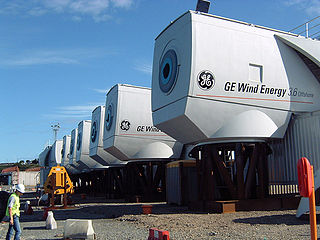
Arklow Bank Wind Park is a 25 megawatt offshore wind farm generating electrical power for the Wicklow region in Ireland. It is the first offshore wind farm in Ireland, and the world's first erection of wind turbines rated over 3 MW. It is located on the Arklow Bank, a shallow water sandbank in the Irish Sea, around 10 kilometers (6.2 mi) off the coast of Arklow with an area of 27 by 2.5 kilometres.
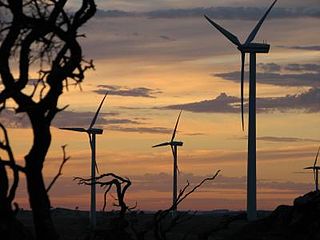
Canunda Wind Farm is a $92.5 million, 46 MW wind power project located on grazing land approximately 16 kilometres south of Millicent, and 6 kilometres west of Tantanoola in South Australia. It is jointly owned by GDF Suez Energy AustraliaEn 72%) and Mitsui (28%).

Wind power became a significant energy source within South Australia over the first two decades of the 21st century. In 2015, there was an installed capacity of 1,475 MW, which accounted for 34% of electricity production in the state. This accounted for 35% of Australia's installed wind power capacity. In 2021, there was an installed capacity of 2052.95 MW, which accounted for 42.1% of the electricity production in the state in 2020.

Lake Bonney Wind Farm is a wind farm near Millicent, South Australia, Australia. The wind farm is south of, and contiguous with, Canunda Wind Farm. Both are built along the Woakwine Range - a line of stabilised sand dunes that once were coastal.

Biglow Canyon Wind Farm is an electricity generating wind farm facility in Sherman County, Oregon, United States. It is owned by Portland, Oregon-based Portland General Electric and began operations in 2007. With the completion of phase 3 of the project it has a generating capacity of 450 megawatts. It is located roughly five miles (8 km) northeast of Wasco, Oregon, and about ten miles (16 km) southeast of Rufus, Oregon. Biglow Canyon Wind Farm covers 25,000 acres (10,000 ha) in the Columbia River Gorge.
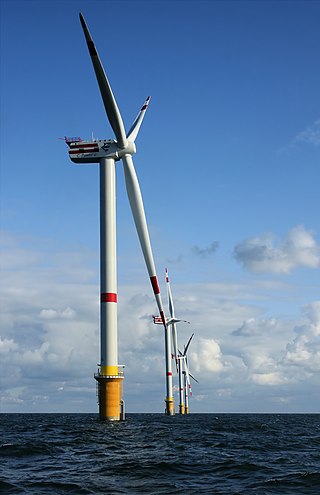
A wind turbine is a device that converts the kinetic energy of wind into electrical energy. As of 2020, hundreds of thousands of large turbines, in installations known as wind farms, were generating over 650 gigawatts of power, with 60 GW added each year. Wind turbines are an increasingly important source of intermittent renewable energy, and are used in many countries to lower energy costs and reduce reliance on fossil fuels. One study claimed that, as of 2009, wind had the "lowest relative greenhouse gas emissions, the least water consumption demands and the most favorable social impacts" compared to photovoltaic, hydro, geothermal, coal and gas energy sources.
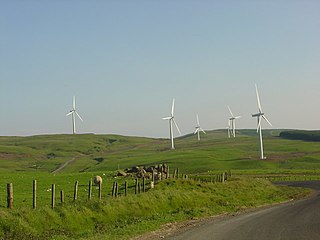
Hadyard Hill Wind Farm is located in Carrick district of South Ayrshire. Costing £85 million, the wind farm consists of 52 three-bladed Siemens wind turbines, each capable of generating 2.3 megawatts (MW) of power, giving a total output of 120 MW. This was Britain's most powerful wind farm when it was commissioned in March 2006.
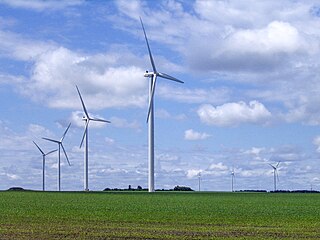
St. Leon Wind Farm is Manitoba's first wind farm, in St. Leon, Manitoba, Canada. In the first phase completed in 2006, 63 wind turbines were erected over a 93-square-kilometre (36 sq mi) area, capable of delivering 99 megawatts (MW). In 2011 a further 10 turbines were purchased, expanding the capacity of the project to 120 megawatts.

Coopers Gap Wind Farm is a 453 megawatt wind farm in the Western Downs and South Burnett regions of Queensland, Australia. It is located approximately 175 km north-west of the state capital Brisbane, and 50 kilometres south-west of Kingaroy and 65 kilometers north of Dalby. When construction was announced to be completed on 30 April 2020, it became the largest wind farm in Australia. This record was held until 10 December 2020 when the Stockyard Hill Wind Farm in Victoria was completed.
In 2016, Arizona had 268 megawatts (MW) of wind powered electricity generating capacity, producing 0.5% of in-state generated electricity.
The Hampton Wind Park is a wind power station near Hampton, south-east of Lithgow, New South Wales, Australia. Initiated, developed and operated privately by a landholder, the farm has two wind turbines, with a total nameplate capacity of 1.32 MW of renewable electricity which is supplied to the main electricity grid.
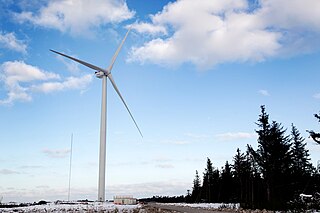
The Vestas V164 is a three-bladed offshore wind turbine, produced by Vestas, with a nameplate capacity of up to 10 megawatts, a world record. Vestas revealed the V164's design in 2011 with the first prototype unit operated at Østerild in northern Denmark in January 2014. The first industrial units were installed in 2016 at Burbo Bank, off the west coast of the United Kingdom. By 2021, Vestas had produced 500 of the series.
The Taralga Wind Farm is a wind farm located near Taralga, New South Wales. Owned by Pacific Blue, it commenced operation in 2015.

The South Plains Wind Farm, is located between Floydada, Texas and South Plains, Texas, on the high plains of the Llano Estacado in Floyd County. Completed in 2016, the wind farm was constructed in two phases that have a total generating capacity of 500.3 megawatts (MW).
The Port Augusta Renewable Energy Park is a combined wind and solar farm under construction south of Port Augusta in South Australia, Australia. The solar farm is planned to be at the northern end of the site, west of the Augusta Highway and south of Sundrop Farms. The wind turbines will be on both sides of the Augusta Highway, extending south as far as the road to Horrocks Pass. Construction formally started in October 2020 and is estimated to take about 18 months to complete. The total site is about 5,400 hectares.
Warradarge Wind Farm is located 15 kilometres (9.3 mi) northeast of Warradarge, and 30 kilometres (19 mi) southeast of Eneabba in the Mid West region of Western Australia. Construction commenced in 2019 and the first of its planned 51 turbines was completed on 21 January 2020. The wind farm has been operational since then.
Taiba N'Diaye Wind Power Station,, is a 158.7 MW (212,800 hp) wind power plant in Senegal. The power station is the largest wind power station in West Africa, by generation capacity.
















